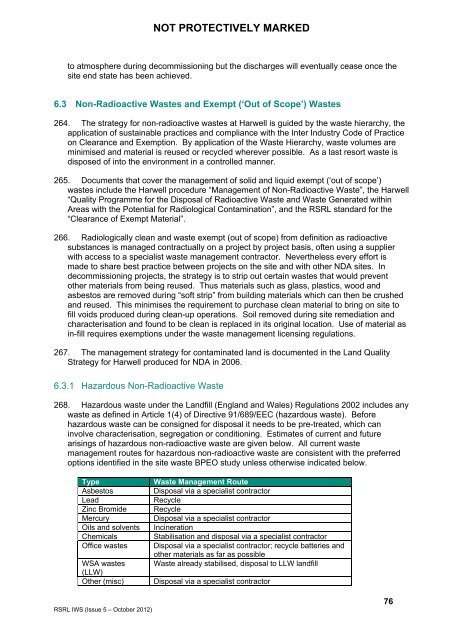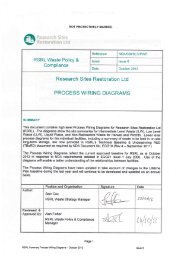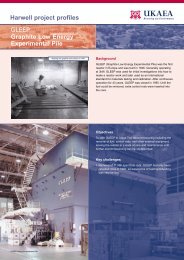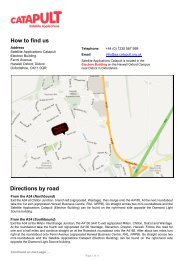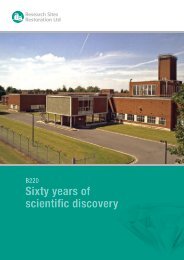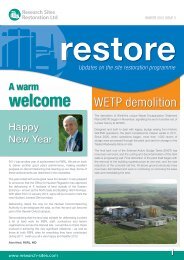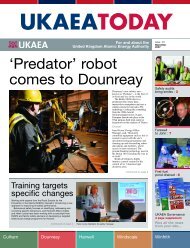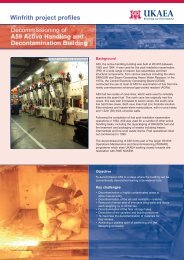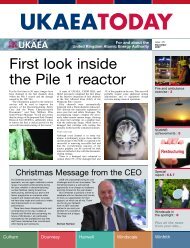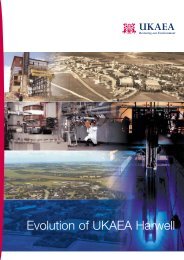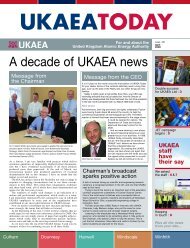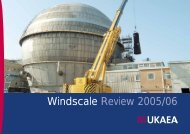RSRL Integrated Waste Strategy - Issue 5- Oct 2012.pdf
RSRL Integrated Waste Strategy - Issue 5- Oct 2012.pdf
RSRL Integrated Waste Strategy - Issue 5- Oct 2012.pdf
Create successful ePaper yourself
Turn your PDF publications into a flip-book with our unique Google optimized e-Paper software.
NOT PROTECTIVELY MARKEDto atmosphere during decommissioning but the discharges will eventually cease once thesite end state has been achieved.6.3 Non-Radioactive <strong>Waste</strong>s and Exempt (‘Out of Scope’) <strong>Waste</strong>s264. The strategy for non-radioactive wastes at Harwell is guided by the waste hierarchy, theapplication of sustainable practices and compliance with the Inter Industry Code of Practiceon Clearance and Exemption. By application of the <strong>Waste</strong> Hierarchy, waste volumes areminimised and material is reused or recycled wherever possible. As a last resort waste isdisposed of into the environment in a controlled manner.265. Documents that cover the management of solid and liquid exempt (‘out of scope’)wastes include the Harwell procedure “Management of Non-Radioactive <strong>Waste</strong>”, the Harwell“Quality Programme for the Disposal of Radioactive <strong>Waste</strong> and <strong>Waste</strong> Generated withinAreas with the Potential for Radiological Contamination”, and the <strong>RSRL</strong> standard for the“Clearance of Exempt Material”.266. Radiologically clean and waste exempt (out of scope) from definition as radioactivesubstances is managed contractually on a project by project basis, often using a supplierwith access to a specialist waste management contractor. Nevertheless every effort ismade to share best practice between projects on the site and with other NDA sites. Indecommissioning projects, the strategy is to strip out certain wastes that would preventother materials from being reused. Thus materials such as glass, plastics, wood andasbestos are removed during “soft strip” from building materials which can then be crushedand reused. This minimises the requirement to purchase clean material to bring on site tofill voids produced during clean-up operations. Soil removed during site remediation andcharacterisation and found to be clean is replaced in its original location. Use of material asin-fill requires exemptions under the waste management licensing regulations.267. The management strategy for contaminated land is documented in the Land Quality<strong>Strategy</strong> for Harwell produced for NDA in 2006.6.3.1 Hazardous Non-Radioactive <strong>Waste</strong>268. Hazardous waste under the Landfill (England and Wales) Regulations 2002 includes anywaste as defined in Article 1(4) of Directive 91/689/EEC (hazardous waste). Beforehazardous waste can be consigned for disposal it needs to be pre-treated, which caninvolve characterisation, segregation or conditioning. Estimates of current and futurearisings of hazardous non-radioactive waste are given below. All current wastemanagement routes for hazardous non-radioactive waste are consistent with the preferredoptions identified in the site waste BPEO study unless otherwise indicated below.TypeAsbestosLeadZinc BromideMercuryOils and solventsChemicalsOffice wastesWSA wastes(LLW)Other (misc)<strong>Waste</strong> Management RouteDisposal via a specialist contractorRecycleRecycleDisposal via a specialist contractorIncinerationStabilisation and disposal via a specialist contractorDisposal via a specialist contractor; recycle batteries andother materials as far as possible<strong>Waste</strong> already stabilised, disposal to LLW landfillDisposal via a specialist contractor<strong>RSRL</strong> IWS (<strong>Issue</strong> 5 – <strong>Oct</strong>ober 2012)76


